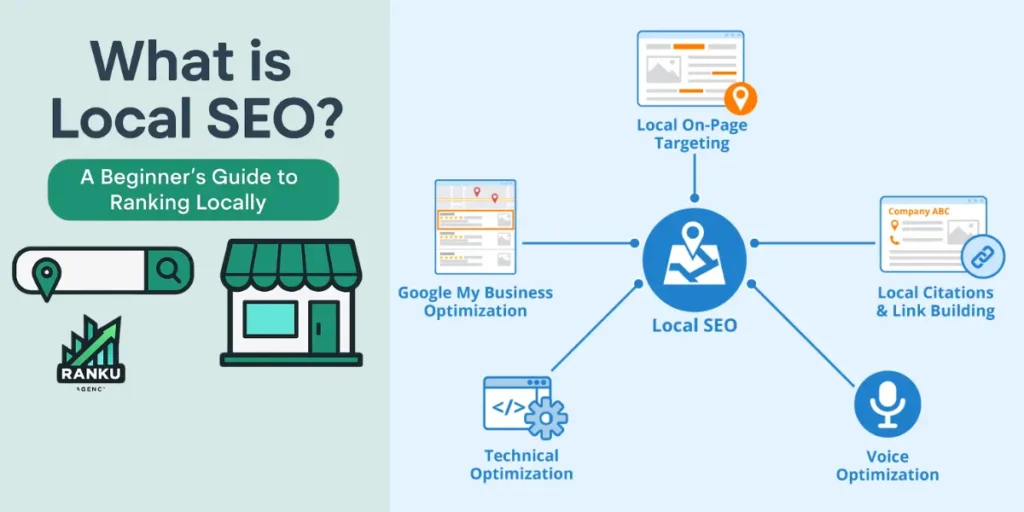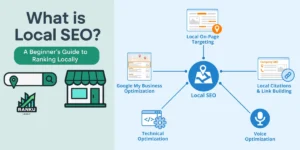Chapter 1: What is SEO?
SEO stands for Search Engine Optimization. It means improving your website or online profile so that more people can find it when they search on Google, Bing, or other search engines.
Now, when we talk about Local SEO, we are talking about people who are searching for businesses near their location.
Chapter 2: What is Local SEO?
Local SEO means optimizing your business so that it appears in local search results — especially on Google Search and Google Maps.
Example:
A person types on Google:
“Best pizza near me”
Google will show local restaurants that are nearby. These businesses appear because they are using Local SEO techniques.
Chapter 3: Why is Local SEO Important?
-
- People prefer businesses that are near their home or office
-
- Mobile users often search for quick and nearby services
-
- Helps small and local businesses grow fast
-
- Builds trust and visibility in your local community
-
- Appears in Google Maps and top Google results
Chapter 4: Key Elements of Local SEO
Let’s break it down into main building blocks of Local SEO:
Google Business Profile (GBP OR GMB)
Your Google Business Profile is your digital shop board on Google.
Tips to optimize your GMB:
-
- Use real photos of your shop, office, or products
-
- Add services and categories clearly (like “AC repair”, “Beauty salon”)
-
- Post weekly updates, offers, or events
-
- Use “questions & answers” to address common doubts
-
- Turn on “chat” so users can message you
Pro Tip: Add keywords in your business description:
“We offer fast and affordable mobile repair in Brooklyn.”
How to Create Google Business Profile?
-
- Add your business details:
-
- Name of your business
-
- Address (physical location)
-
- Phone number
-
- Business hours
-
- Photos of shop or office
-
- Website link
Example:
If you run a salon in Dallas, add pictures of your salon, opening times, and services offered. This helps you appear in searches like:
“Salon near me” or “Haircut in Dallas”
NAP Consistency
NAP = Name, Address, Phone Number
Your business name, address, and phone number should be exactly the same everywhere:
-
- Website
-
- Google Business
-
- Social media
-
- Local directories
Why?
Google checks this info to trust and rank your business higher.
Local Keywords
Use keywords that include your city name or area name.
Examples:
-
- “Electrician in New York”
-
- “Tire repair in Chicago”
-
- “Café in downtown Houston”
Use these keywords in:
-
- Your website title and headings
-
- Blog articles
-
- Meta descriptions
-
- Image alt texts
Online Reviews
Encourage your happy customers to leave positive reviews on your Google Business profile.
Why important?
-
- More reviews = More trust
-
- Google shows businesses with better reviews on top
Tips: Always respond to reviews—good or bad. It shows that you care.
Google Maps Optimization
When your business is listed on Google, people can find you on Google Maps. Make sure:
-
- Your location pin is correct
-
- You add opening hours
-
- You upload photos regularly
Chapter 5: Intermediate Local SEO Tips
Business Listings (Citations)
List your business on websites like:
-
- Yelp
-
- Bing Places
-
- Yellow Pages
-
- Facebook Business
-
- Apple Maps
These are called local citations, and they increase your visibility in local searches.
Mobile-Friendly Website
Most people search from their phones. So your website must be:
-
- Fast loading
-
- Easy to navigate on small screens
-
- Simple layout with clear contact info
Use Google’s Mobile-Friendly Test to check your website.
Add Schema Markup For Local Business Schema
Schema is a type of code that tells Google:
-
- What your business is
-
- Where you are located
-
- Your ratings and hours
You can use Google’s Structured Data Markup Helper to add this easily.
Chapter 6: Advanced Local SEO Strategies
Local Backlinks
Get links to your website from other local websites, such as:
-
- Local blogs
-
- Local news sites
-
- Community event websites
Why?
Backlinks from trusted sites improve your local ranking.
Location-Based Pages
If you serve more than one area, make separate pages for each.
Example:
If you’re a lawyer in California, make pages like:
-
- “Divorce Lawyer in Los Angeles”
-
- “Family Lawyer in San Diego”
Each page should have:
-
- Unique content
-
- Area-specific info
-
- Maps and testimonials
Chapter 7: Local SEO & Voice Search
People now use Google Assistant, Siri, or Alexa to search.
Example voice command:
“Hey Google, where’s the nearest dentist?”
To optimize for voice search:
-
- Use full, natural-sounding sentences
-
- Add FAQs on your website
-
- Focus on “who”, “what”, “where”, and “how much” type questions
Chapter 8: Our Checklist for Local SEO
| Task | Status |
|---|---|
| Create Google Business Profile | ✅ |
| Use local keywords in your site | ✅ |
| Ask for customer reviews | ✅ |
| List business in online directories | ✅ |
| Website mobile-friendly | ✅ |
| Add schema markup | ✅ |
| Get backlinks from local sources | ✅ |
| Voice-search friendly content | ✅ |
Chapter 8: Check Your Local SEO Performance
-
- Google Search Console – See how many people are visiting from search
-
- Google Business Insights – Know how people found you (search, maps, direction)
-
- Moz Local – Track local rankings, citations, and review management
-
- Google Analytics – See which city people are visiting from
Bottom Line
Now you clearly understand what is local SEO – it’s a way to help people in your area find your business online. By using tools like Google Business Profile, local keywords, and customer reviews, you can appear higher in search results and grow your local reach. Whether you’re a student or a business owner, learning local SEO gives you a real advantage.
So, if anyone ever asks you what is local SEO, you’ll not only be able to explain it – you’ll know how to make it work in real life.




